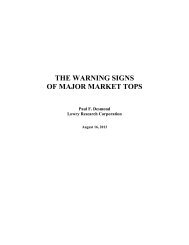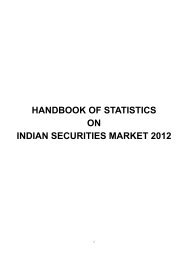1 |
april2016
april2016
You also want an ePaper? Increase the reach of your titles
YUMPU automatically turns print PDFs into web optimized ePapers that Google loves.
Examples from the Financial Industry<br />
Moving from the general to the specific, several recent financial debacles demonstrate the role of corporate culture in<br />
financial failure. Let us start with a control case, the fall of Long-Term Capital Management (LTCM). In organizational<br />
theorist Charles Perrow’s terminology, its collapse was a “normal accident.” That is, it was caused by a combination of<br />
“tight coupling” in the engineering sense—in which the execution of one process depends critically on the successful<br />
completion of another—and complex interactions within the financial system. To summarize a well-known story very<br />
briefly, LTCM’s sophisticated models were caught offguard by the aftermath of Russia’s default on its GKO bonds on August<br />
17, 1998, triggering a short and vicious cycle of losses and flights to liquidity, and ultimately leading to its bailout on<br />
September 23, 1998.<br />
On paper, LTCM’s corporate culture was excellent. Its composition was elite: founded by John Meriwether, the former<br />
head of bond trading at Salomon Brothers, and future Nobelists Robert C. Merton and Myron Scholes. Its culture was<br />
individualistic, as many trading groups are, but it derived its authority from a legal-rational basis, the superiority of its<br />
mathematics. Its corporate culture played little direct role in its failure. In fact, with much of their personal fortunes<br />
invested in the business, LTCM’s managing partners were perfectly aligned with their investors. Not a single client has<br />
sued them for inappropriate behavior. Not a single regulator has cited them for violations of any sort.<br />
However, Wall Street’s corporate culture was apparently caught off-guard by LTCM’s predicament. It had perceived LTCM<br />
to be a paragon of Wall Street’s highest values—a combination of intelligence, market savvy, and ambition that was sure<br />
to succeed—when a more accurate assessment of LTCM might have been as an experimental engineering firm, working<br />
daringly (or hubristically, as some have argued) on the cutting edge. Their creditors notoriously gave LTCM virtually no<br />
“haircut” on their loans, on the assumption that their trades were essentially risk-free. In addition to these very low, or<br />
even zero, margin requirements, LTCM was able to negotiate other favorable credit enhancements with its counterparties,<br />
including two-way collateral requirements, rehypothecation rights, and high thresholds for loss. These were often made<br />
on the strength of their reputation, rather than detailed examination of LTCM’s methods. Daniel Napoli, then Merrill<br />
Lynch’s head of risk management, was quoted as saying, “We had no idea they would have trouble—these people were<br />
known for risk management. They had taught it; they designed it [emphasis in original].” (Napoli himself lost his position<br />
shortly after LTCM’s collapse.) LTCM’s failure may be viewed as akin to the failure of a bridge whose experimental<br />
materials were exposed to an unfamiliar stress, but the behavior of LTCM’s creditors is more likely a failure of their<br />
corporate culture.<br />
Corporate cultures can be overconfident in their abilities to assess risk. This can be seen in the fall of the large multinational<br />
insurer, American International Group (AIG), in 2008. Under its original chairman, Maurice “Hank” Greenberg, AIG was<br />
run not merely hierarchically, but almost feudally, with reciprocal chains of loyalty and obligation centered on Greenberg.<br />
In fact, Greenberg had structured AIG’s compensation plan deliberately to promote lifetime loyalty to the firm. Greenberg<br />
APRIL 2016<br />
52 | TECHNICALLY SPEAKING




